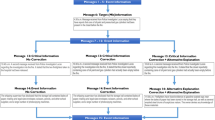Abstract
This paper re-examines the openended/dichotomous choice question in the lab. It hasearlier been suggested that the dichotomous choiceformat suffers from anchoring and yea-saying.Comparing actual economic commitments for a privategood with a significant market value, we cannot rejectthe null hypothesis of equal WTP for the two formats.We conclude that problems with DC might be due toissues of how the survey is framed, not the DCquestion itself.
Similar content being viewed by others
References
Ayer, M., H. D. Brunk, G. M. Ewing, W. T. Reid and E. Silverman (1955), ‘An Empirical Distribution Function for Sampling with Incomplete Information’, Annals of Mathematical Statistics 26, 641-647.
Boyle, K. J., R. F. Johnson, D. W. McCollum, W. H. Desvousges, R. W. Dunford and S. P. Hudson (1996), ‘Valuing Public Goods: Discrete Versus Continuous Contingent Valuation Responses’, Land Economics 72, 381-396.
Boyle, K. J., H. F. MacDonald, H. Cheng and D. W. McCollum (1998), ‘Bid Design and Yea Saying in Single-bounded, Dichotomous-choice Questions’, American Journal of Agricultural Economics 74, 49-64.
Couch, A. and K. Keniston (1960), ‘Yeasayers and Naysayers: Agreeing Response Set as a Personality Variable’, Journal of Abnormal and Social Psychology 60, 151-174.
Cummings, R. G. and G. W. Harrison (1994), ‘Was the Ohio Court Well Informed in Their Assessment of the Accuracy of the Contingent Valuation Method?’, Natural Resources Journal 34(1), 1-36.
Cummings, R. G., G. W. Harrison and E. E. Rutström (1995), ‘Homegrown Values and Hypothetical Surveys: Is the Dichotomous Choice Approach Incentive Compatible?’, American Economic Review 85, 260-266.
Davis, D. D. and C. A. Holt (1993), Experimental Economics, New Jersey, Princeton: Princeton University Press.
Frykblom, P. (1997), ‘Hypothetical Question Modes and Real Willingness to Pay’, Journal of Environmental Economics and Management 34, 275-287.
Green, D., K. Jacowitz, D. Kahneman and D. McFadden (1998), ‘Referendum Contingent Valuation, Anchoring, and Willingness to Pay for Public Goods’, Resource and Energy Economics 20, 85-116.
Hanemann, M. W. (1994), ‘Valuing the Environment Through Contingent Valuation’, Journal of Economic Perspectives 8, 19-43.
Herriges, J. A. and J. F. Shogren (1996), ‘Starting Point Bias in Dichotomous Choice Valuation with Follow-up Questioning’, Journal of Environmental Economics and Management 30, 112-131.
Hoehn, J. P. and A. Randall (1987), ‘A Satisfactory Benefit Cost Indicator from Contingent Valuation’, Journal of Environmental Economics and Management 12, 226-247.
Holmes, T. P. and R. A. Kramer (1995), ‘An Independent Sample Test of Yea-saying and Starting Point Bias in Dichotomous-choice Contingent Valuation’, Journal of Environmental Economics and Management 29, 121-132.
Jakobsson, K. M. and A. K. Dragun (1996), Contingent Valuation and Endangered Species: Methodological Issues and Application. Aldershot: Edward Elgar.
Kanninen, B. J. (1995), ‘Bias in Discrete Choice Response Contingent Valuation’, Journal of Environmental Economics and Management 28, 114-125.
Kealy, M. J. and R. W. Turner (1993), ‘Testing of Equality of Contingent Valuations’, American Journal of Agricultural Economics 75(2), 321-331.
Kmenta, J. (1986), Elements of Econometrics. London: Macmillan.
Kriström, B. (1993), ‘Comparing Continuous and Discrete Contingent Valuation Questions’, Environmental and Resource Economics 3, 63-71.
Li, C. Z. and Fredman, P. (1994), On Reconciliation of the Discrete Choice and Open-ended Responses in Contingent Valuation Experiments. Dissertation, Umeå Economic Studies, 341, Umeå: Umeå University.
Mitchell, C. Z. and R. T. Carson (1989), Using Surveys to Value Public Goods: The Contingent Valuation Method. Baltimore: John Hopkins Press.
National Oceanic and Atmospheric Administration (1993), ‘Report of the NOAA Panel on Contingent Valuation’, Federal Register 58(10), 4602-4614, January 11.
Neill, H. R., R. G. Cummings, P. T. Ganderton, G. W. Harrison and T. McGuckin (1994), ‘Hypothetical Surveys and Real Economic Commitments’, Land Economics 70(2), 145-154.
Ready, R. C., J. C. Buzby and D. Hu (1996), ‘Differences Between Continuous and Discrete Choice Value Estimates’, Land Economics 72, 397-411.
SAS Institute (1990), SAS/STAT User's guide, 2, Cary, NC.
Siegel, S. and J. N. Castellan, Jr. (1988), Nonparametric Statistics for the Behavioral Sciences, New York: McGraw-Hill.
Author information
Authors and Affiliations
Rights and permissions
About this article
Cite this article
Frykblom, P., Shogren, J.F. An Experimental Testing of Anchoring Effects in Discrete Choice Questions. Environmental and Resource Economics 16, 329–341 (2000). https://doi.org/10.1023/A:1008388421810
Issue Date:
DOI: https://doi.org/10.1023/A:1008388421810




